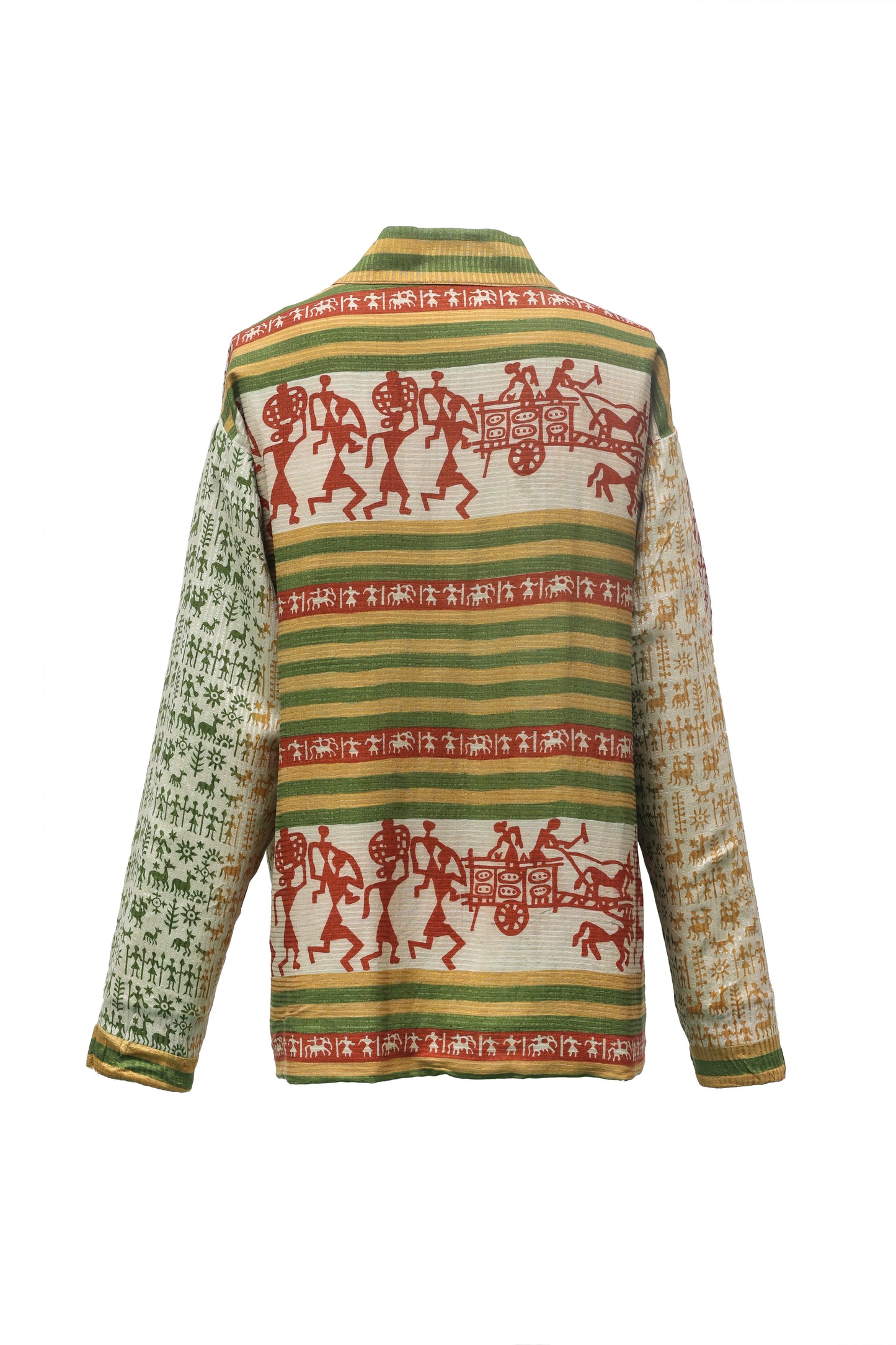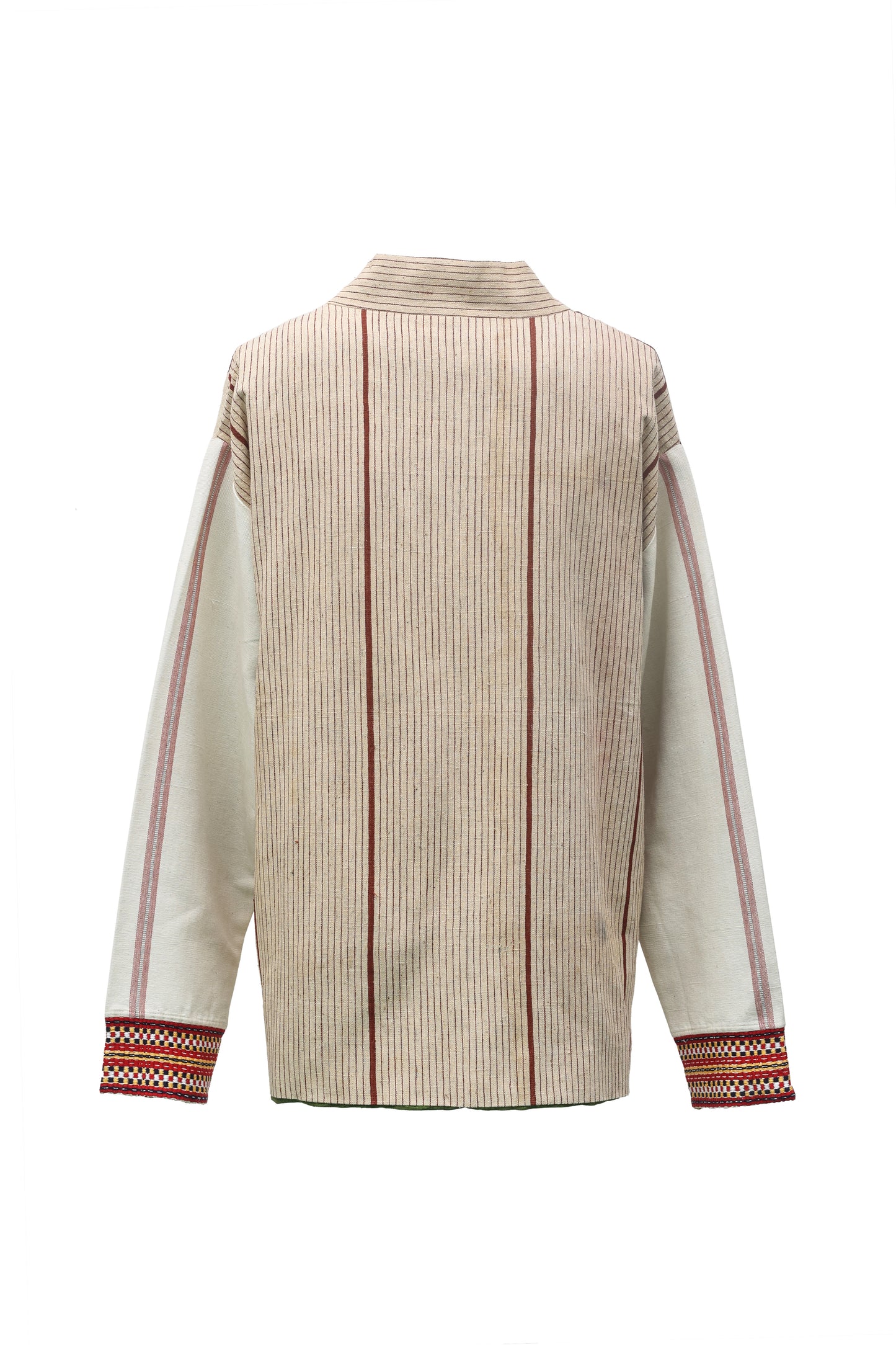KAJ.006
This one of a kind garment is reversible and unique from each side.
This exceptional string knot kimono style jacket is made using tribal Panika hand woven fabric , with Central Asian kilim elements on the pockets and sleeves. Inside we used gorgeous tribal hand painted Kalamkari tussar silk.
Panika weaving traditions of Bastar
This unique textile is sourced from the tribal Bastar region of India and one of the finest examples of Tribal art form. The fabric is made from natural hand spun cotton, coated with rice starch to give it strength. The colour is natural dyed from Aal , Indian Mulbery.
The craft of dyeing yarns with Aal and weaving them into textiles is a traditional form that was carried forward across generations. In the absence of written records, oral and personal communication collected during the course of research point to its practice for at least two hundred years.
Kalamkari is a type of hand-painted or block-printed cotton/silk produced in Isfahan Iran, and in the Indian state of Andra Pradesh/West Bengal.
Only natural dyes are used in Kalamkari, which involves twenty-three steps. An ancient Indian art form older than 3000 years, this form of ‘work with a pen’ is very prevalent and sought after
Under medieval Islamic rule, the term Kalamkari was derived from the words "kalam", which means "pen" in Telugu, and "kari", which means craftsmanship. This became popular under the patronage of the Golconda sultanate.
Kalamkari specifically depicts epics such as the Ramayana and Mahabharata. However, there are recent applications of the Kalamkari technique to depict Buddha and Buddhist art forms In later periods, many aesthetically good figures such as musical instruments, small animals, flowers, Buddha and few Hindu symbols, like yantras were also introduced to Kalamkari.
Tussar silk originated from medieval period. It is made by collecting the cocoons after silkworms has already emerged. Tribal communities residing in forests collect the cocoons. The magic of this fabric is that keeps you warm in the winter and cool in the summer.
Couldn't load pickup availability
DETAILS
DETAILS
This one of a kind garment is reversible and unique from each side.
This exceptional string knot kimono style jacket is made using tribal Panika hand woven fabric , with Central Asian kilim elements on the pockets and sleeves. Inside we used gorgeous tribal hand painted Kalamkari tussar silk.
Panika weaving traditions of Bastar
This unique textile is sourced from the tribal Bastar region of India and one of the finest examples of Tribal art form. The fabric is made from natural hand spun cotton, coated with rice starch to give it strength. The colour is natural dyed from Aal , Indian Mulbery.
The craft of dyeing yarns with Aal and weaving them into textiles is a traditional form that was carried forward across generations. In the absence of written records, oral and personal communication collected during the course of research point to its practice for at least two hundred years.
Kalamkari is a type of hand-painted or block-printed cotton/silk produced in Isfahan Iran, and in the Indian state of Andra Pradesh/West Bengal.
Only natural dyes are used in Kalamkari, which involves twenty-three steps. An ancient Indian art form older than 3000 years, this form of ‘work with a pen’ is very prevalent and sought after
Under medieval Islamic rule, the term Kalamkari was derived from the words "kalam", which means "pen" in Telugu, and "kari", which means craftsmanship. This became popular under the patronage of the Golconda sultanate.
Kalamkari specifically depicts epics such as the Ramayana and Mahabharata. However, there are recent applications of the Kalamkari technique to depict Buddha and Buddhist art forms In later periods, many aesthetically good figures such as musical instruments, small animals, flowers, Buddha and few Hindu symbols, like yantras were also introduced to Kalamkari.
Tussar silk originated from medieval period. It is made by collecting the cocoons after silkworms has already emerged. Tribal communities residing in forests collect the cocoons. The magic of this fabric is that keeps you warm in the winter and cool in the summer.
Please note, that due to antique nature of the fabrics there may be signs of past experiences - we believe it adds value and a meaning to the garments.
Some naturally dyed fabrics even after lasting generations may leave colour
Please keep in mind that all Karatoyaa pieces are Dry Clean only with the Professional service provider.
COMPOSITION
COMPOSITION
UPCYCLED SILK+WOOL
SIZE & FIT
SIZE & FIT
ONESIZE
waist - 146cm
sleeve - 62cm
CARE
CARE
• Please note, that due to antique nature of the fabrics there may be signs of past experiences - we believe it adds value and a meaning to the garments.
• Some naturally dyed fabrics even after lasting generations may leave colour
• Please keep in mind that all Karatoyaa pieces are Dry Clean only with the Professional service provider.
Share








